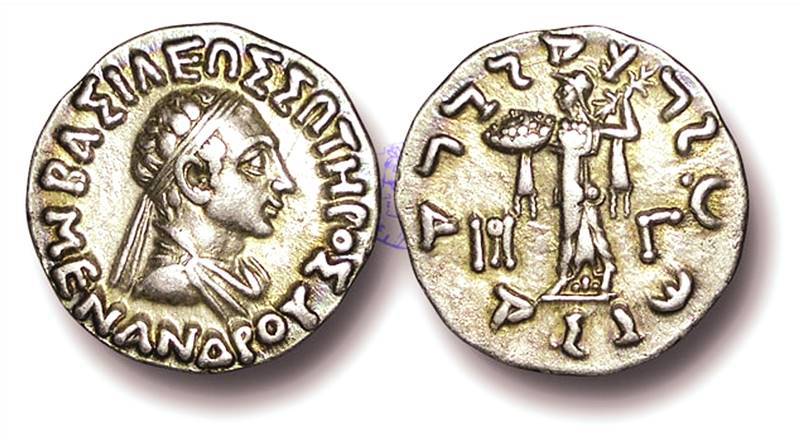
This photograph depicts a coin that was struck during Menander’s period in mid second century BC.
Menander, a king of Indo-Greek line, ruled north western India. Though the exact dates of his reign are not known, King Menander is the most famous of Indo-Greek kings for a number of reasons. His patronage of Buddhism is recorded in the various Buddhist religious books. One such book is Milindapanha, which is actually a conversation between the king and the Buddhist sage Nagasena about various philosophical questions. Menander is also famous for his coins, which are found in large numbers in various parts of northern and western India.
Menander reign saw growing trade between India and Europe via west Asia. To facilitate trade and commerce Menander issued a large number of coins. These coins were struck in the well-established Indo-Greek fashion with elaborate details. His silver coins were known as Drachms.
These coins carried legends in both Greek and Kharosthi. The legends on his coins read the following: Maharaja Tratarasa Menadrasa. The earlier silver coins carried a portrait of goddess Athena on the obverse and the figure of an owl on the reverse.
In the later issues, these coins also carried the portrait of the king on the obverse. The reverse of these later coins carried the figure of Athena Alkidemos throwing a thunderbolt. After this, Athena Alkidemos became the royal standard emblem of several other Indo-Greek kings and rulers.
These silver coins were very light and weighed a little more than one gram to a little less than 2.5 grams.
Another series of coins show the king wearing a helmet and throwing a spear. The other side depicted the portrait of goddess Athena. The legend of these coins read Of King Menander, the Saviour. These coins weighed 13.03 grams each. These coins were probably special issues to mark some significant event during his reign.
A number of bronze coins are also traced to his rule. These coins were of relatively less value.
Menander’s coins have been found widely in varied geographical regions such as modern day Afghanistan, Indian state of Kashmir, Punjab, and Gujarat. Even centuries after his reign, his coins were in use among traders of Gujarat.
Menander, a king of Indo-Greek line, ruled north western India. Though the exact dates of his reign are not known, King Menander is the most famous of Indo-Greek kings for a number of reasons. His patronage of Buddhism is recorded in the various Buddhist religious books. One such book is Milindapanha, which is actually a conversation between the king and the Buddhist sage Nagasena about various philosophical questions. Menander is also famous for his coins, which are found in large numbers in various parts of northern and western India.
Menander reign saw growing trade between India and Europe via west Asia. To facilitate trade and commerce Menander issued a large number of coins. These coins were struck in the well-established Indo-Greek fashion with elaborate details. His silver coins were known as Drachms.
These coins carried legends in both Greek and Kharosthi. The legends on his coins read the following: Maharaja Tratarasa Menadrasa. The earlier silver coins carried a portrait of goddess Athena on the obverse and the figure of an owl on the reverse.
In the later issues, these coins also carried the portrait of the king on the obverse. The reverse of these later coins carried the figure of Athena Alkidemos throwing a thunderbolt. After this, Athena Alkidemos became the royal standard emblem of several other Indo-Greek kings and rulers.
These silver coins were very light and weighed a little more than one gram to a little less than 2.5 grams.
Another series of coins show the king wearing a helmet and throwing a spear. The other side depicted the portrait of goddess Athena. The legend of these coins read Of King Menander, the Saviour. These coins weighed 13.03 grams each. These coins were probably special issues to mark some significant event during his reign.
A number of bronze coins are also traced to his rule. These coins were of relatively less value.
Menander’s coins have been found widely in varied geographical regions such as modern day Afghanistan, Indian state of Kashmir, Punjab, and Gujarat. Even centuries after his reign, his coins were in use among traders of Gujarat.

